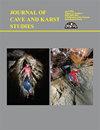新墨西哥加利纳斯山热液含ree萤石脉和角砾岩的岩石地球化学载体及矿物共生
IF 0.5
4区 地球科学
Q4 GEOSCIENCES, MULTIDISCIPLINARY
引用次数: 0
摘要
加利纳斯山脉位于新墨西哥州林肯和托兰斯县,是热液含稀土萤石脉和角砾岩的所在地。稀土元素(REE)存在于bastnäsite-(Ce) ([Ce,La] co3f)中,也是几个重要碳酸盐岩矿床(如加州帕斯山;中国的白云鄂博)。20世纪初至50年代,在加利纳斯山脉地区记录了少量稀土、萤石、Cu、Pb、Zn、Ag和Fe的生产。含稀土萤石脉和角砾岩赋存于二叠纪沉积岩中,也赋存于28-30 Ma之间的粗面岩/正长岩岩和岩脉中。以往的研究已经描述了加里纳斯山脉稀土元素的赋存状态,但热液作用对该地区稀土元素运移和沉积的控制作用尚不清楚。本研究结合热液含ree萤石脉和角砾岩的显微结构观察、矿物化学和全岩化学,确定了矿脉类型、蚀变样式,建立了详细的矿物共生关系。本研究的目的是通过将薄片和矿床尺度观测与矿物和全岩地球化学相结合,确定该区稀土富集带的岩石地球化学矢量。该地区是研究热液过程对碱性富f岩浆热液系统中稀土元素运输/沉积作用的特殊天然实验室,因为世界上很少有矿床具有如此保存完好和暴露的地质。从露头、远景坑和矿山排土场采集了含±重晶石±bastnäsite-(Ce)的热液脉和角砾岩手样。利用光学显微镜对不同萤石脉进行了矿物鉴定,确定了不同萤石脉的结构特征和横切关系。观察到多代矿脉:1)早期钾长石矿脉;Ii)重晶石萤石±赤铁矿±石英脉;Iii) bastnäsite-fluorite静脉;Iv)晚期石英和方解石脉。Bastnäsite-(Ce)通常在覆盖早期重晶石-萤石矿脉的矿脉中发现,含有显示溶解结构(骨架化晶体)的重晶石。阴极发光(CL)显微镜显示至少三种不同的萤石世代具有复杂的叠印,包括与bastnäsite-(Ce)共生的一代。这些结构观测表明,加里纳斯山脉地区稀土矿化的关键控制因素是重晶石-萤石脉的耦合溶蚀和后期bastnäsite-fluorite脉的沉淀。对多代萤石进行了LA-ICP-MS分析,以将萤石化学与结构关系联系起来。揭示了三种不同的球粒陨石归一化稀土模式,包括:1)低重稀土富集;ii)低重稀土(LREE)与贫重稀土(HREE);iii) LREE贫化,HREE富集。取代独角石的一代萤石含有超过1%的总REE。利用IMDEX ioGAS TM程序分析新墨西哥州地质矿产局数据库中的地球化学全岩数据,确定岩石类型、蚀变样式和脉型的地球化学特征。初步数据分析表明,Ba、F和总稀土氧化物(TREO)呈正相关。这些趋势与观察到的矿脉显微结构相吻合,表明热液流体与重晶石-萤石矿脉的相互作用是确定该区地球化学矢量的关键过程。本文章由计算机程序翻译,如有差异,请以英文原文为准。
Lithogeochemical Vectors and Mineral Paragenesis of Hydrothermal REE-Bearing Fluorite Veins and Breccias in the Gallinas Mountains, New Mexico
The Gallinas Mountains district located in Lincoln and Torrance Counties, New Mexico, is host to hydrothermal REE-bearing fluorite veins and breccias. Rare earth elements (REE) are found in bastnäsite-(Ce) ([Ce,La]CO 3 F), which is also the primary ore mineral mined in several important carbonatite deposits (e.g. Mountain Pass in California; Bayan Obo in China). Minor production of REE, fluorite, Cu, Pb, Zn, Ag, and Fe has been recorded in the Gallinas Mountains district between the early 1900s and the 1950s. The REE-bearing fluorite veins and breccias are hosted in Permian sedimentary rocks as well as genetically related trachyte/syenite sills and dikes emplaced between 28-30 Ma. Previous studies have described the REE occurrences in the Gallinas Mountains, but the controls of hydrothermal processes on the transport and deposition of REE in the district remain unclear. In this study, we combine microtextural observations with mineral and whole rock chemistry of hydrothermal REE-bearing fluorite veins and breccias to determine the vein types, alteration styles, and establish a detailed mineral paragenesis. The goal of this study is to determine lithogeochemical vectors towards REE enriched zones in the district by linking thin section and deposit scale observations with mineral and whole rock geochemistry. This district is an exceptional natural laboratory for studying the role of hydrothermal processes for transport/deposition of REE in an alkaline F-rich magmatic-hydrothermal system because very few deposits worldwide have such well-preserved and exposed geology. Hand samples of hydrothermal veins and breccias containing ± barite ± bastnäsite-(Ce) were collected from outcrops, prospect pits, and mine dumps. Optical microscopy was used to identify minerals and determine the textural features and crosscutting relationships of the different fluorite veins. Multiple vein generations have been observed: i) early K-feldspar veins; ii) barite-fluorite ± hematite ± quartz veins; iii) bastnäsite-fluorite veins; iv) late quartz and calcite veins. Bastnäsite-(Ce) is commonly found in veins overprinting earlier barite-fluorite veins and contain barite that display dissolution textures (skeletonized crystals). Cathodoluminescence (CL) microscopy reveals at least three distinct fluorite generations with complex overprinting, including a generation intergrown with bastnäsite-(Ce). These textural observations suggest a key control of REE mineralization in the Gallinas Mountains district is by coupled dissolution of barite-fluorite veins and precipitation of later bastnäsite-fluorite veins. LA-ICP-MS analysis was performed on multiple fluorite generations to link fluorite chemistry with textural relationships. At least three distinct chondrite-normalized REE patterns are revealed, including: i) enriched LREE; ii) flat LREE with depleted HREE; iii) depleted LREE with enriched HREE. One fluorite generation seen replacing euhedra contains over 1% total REE. Geochemical whole rock data within the New Mexico Bureau of Geology and Mineral Resources database were analyzed using the IMDEX ioGAS TM program to define geochemical signatures of rock types, alteration styles, and vein types. Preliminary data analysis indicates a positive correlation between Ba, F, and total rare earth oxides (TREO). These trends corroborate with the observed vein microtextures, suggesting that the interaction of a hydrothermal fluid with the barite-fluorite veins represents a key process for defining geochemical vectors in the district.
求助全文
通过发布文献求助,成功后即可免费获取论文全文。
去求助
来源期刊

Journal of Cave and Karst Studies
地学-地球科学综合
CiteScore
1.90
自引率
0.00%
发文量
6
审稿时长
>12 weeks
期刊介绍:
The Journal of Cave and Karst Studies is a multidisciplinary journal devoted to cave and karst research. The Journal is seeking original, unpublished manuscripts concerning the scientific study of caves or other karst features. Authors do not need to be members of the National Speleological Society, but preference is given to manuscripts of importance to North American speleology.
 求助内容:
求助内容: 应助结果提醒方式:
应助结果提醒方式:


